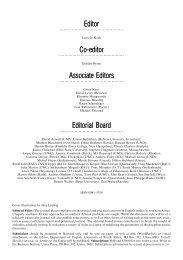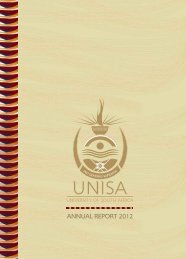pdf: 6.426kb - University of South Africa
pdf: 6.426kb - University of South Africa
pdf: 6.426kb - University of South Africa
Create successful ePaper yourself
Turn your PDF publications into a flip-book with our unique Google optimized e-Paper software.
others (Wolf 1991:58; Sharon 1978:3; Luna 1986:33;<br />
Dobkin de Rios 1984:93).<br />
Luna (1991:32) also distinguishes between murayas<br />
and sumirunas, as well as bancos, according to<br />
their mastering <strong>of</strong> the three basic realms: water, jungle<br />
and sky. A banco according to the same author, is<br />
master <strong>of</strong> the jungle realm, has contact with the spirits<br />
<strong>of</strong> the sky, and understands secrets related to the<br />
earth, but he is unable to enter the underwater realm.<br />
Wynand Koch with another painting by Don Francisco<br />
A muraya is, first <strong>of</strong> all, a master <strong>of</strong> the water and the<br />
jungle realms. He is knowledgeable about plants and<br />
animals, and is able to live for periods <strong>of</strong> time in the<br />
subaquatic realm, finding food there. But he is unable<br />
to ascend to the sky. To become a muraya a<br />
practitioner needs to contact the spirits <strong>of</strong> the water,<br />
such as mermaids, yakurunas, and dolphins.<br />
A sumiruna is the highest degree a vegetalista may<br />
reach, because he or she is able to master all three<br />
realms: jungle, water, and sky. This division is not<br />
generalized in the Peruvian Amazon (Luna 1991:32),<br />
and many people use these three terms as more or less<br />
synonymous. This might be the reason why, in my<br />
conversations with informants, I only encountered the<br />
term banco.<br />
According to Luna (1986:36), vegetalistas are the<br />
only reliable repositories <strong>of</strong> the Amazonian world<br />
view. He believes that they represent a case <strong>of</strong><br />
transitional shamanism, who incorporate more `modern'<br />
elements, and are between two different economic<br />
systems: a subsistence economy (they all have<br />
their chacras) and market economy. Many <strong>of</strong> my own<br />
informants also made use <strong>of</strong> Western medicine, and<br />
<strong>of</strong>ten prescribed pharmaceutical medicines, which in<br />
most <strong>South</strong> American countries require no prescription<br />
and are available to anyone who can pay the<br />
price. The process <strong>of</strong> referring patients to medical<br />
personnel in cases <strong>of</strong> simple organic disease has its<br />
counterpart in the frequent referrals <strong>of</strong> patients to the<br />
drug healers by medical doctors attached to the city<br />
hospital and in private practice (Dobkin de Rios<br />
1984:68).<br />
Vegetalistas, due to their possession <strong>of</strong> an intimate<br />
understanding <strong>of</strong> the social community in which they<br />
are immersed, and their pr<strong>of</strong>iciency in the use <strong>of</strong><br />
medicinal plants and healing metaphors, contribute<br />
significantly to the physical and mental health <strong>of</strong> the<br />
people <strong>of</strong> rural areas and the urban poor, and they are<br />
<strong>of</strong>ten the only help available to them in critical<br />
situations. Illness is generally conceived as the<br />
product <strong>of</strong> an animated source, either human or<br />
spiritual Ð including the spirits <strong>of</strong> plants, animals,<br />
and natural phenomena Ð and is produced by<br />
intrusion <strong>of</strong> pathogenic objects, soul loss, contamination,<br />
or breaching <strong>of</strong> a taboo (Luna 1991:13).<br />
Vegetalismo is still in Peru today, a very active<br />
practice and vegetalistas are found throughout the<br />
cities and jungle communities. As previously mentioned,<br />
I found a practising vegetalista in virtually<br />
every second casarõÂo which I visited along the stretch<br />
<strong>of</strong> the RõÂo Napo, between Llachapa and Atu n Cocha. I<br />
visited a total <strong>of</strong> thirteen villages, over a stretch <strong>of</strong><br />
about 80 km. These vegetalistas accommodated an<br />
average <strong>of</strong> ten patients per week. Only one <strong>of</strong> these<br />
vegetalistas had someone under training, his wife.<br />
In Iquitos the picture was more favourable with<br />
practising vegetalistas all over the city, especially in<br />
the poorer areas. These vegetalistas had many<br />
patients, with curing sessions sometimes as many as<br />
three times a week. One <strong>of</strong> my informants, Don<br />
Umberto, even had his own little hospital in town with<br />
twelve beds, with an average <strong>of</strong> ten patients per day.<br />
Only two <strong>of</strong> my informants in the city had pupils, the<br />
other five had none, and as DonÄ a Otilia put it: No hay<br />
futuro, (There is no future).<br />
Vocation<br />
Shamans are called to their vocation in different ways.<br />
For some it is a matter <strong>of</strong> ancestral lineage or<br />
hereditary bonds establishing the person in that<br />
position or a situation where a would-be shaman<br />
seeks initiation from one already established in this<br />
role. In other cases it seems almost as if the spirits<br />
have chosen the shaman, rather than the other way<br />
around. These are the `greater shamans' Ð those who<br />
have been called spontaneously through dreams or<br />
mystical visions to embody supernatural power. Those<br />
who have simply inherited their role are regarded as<br />
`lesser shamans' and hold a lower status in society<br />
(Drury 1982:6).<br />
ISSN 0256±6060±Unisa Lat. Am. Rep. 16(2) 2000 51

















